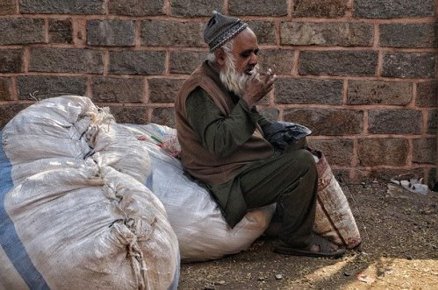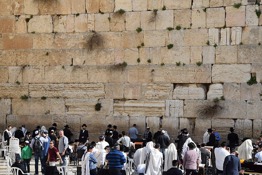Bi'ur and viduy ma'aserot

What is involved in the mitzvah of bi'ur ma'aserot? Can we perform viduy ma'aserot today? On two unique mitzvot that occur twice during the shemitah cycle. Chapter 26 of the Consumer's Guide to Shemitah.
For the practical Halachot and visual guide of Bi'ur Ma'aserot and Viduy Ma'aserot, see here.
A. Halachic principles of bi'ur[1] and viduy ma'aserot[2]
- The mitzvah of bi'ur ma'aserot occurs during the shemitah year on the last day of chol hamo'ed Pesach (eve of the seventh day of Pesach).[3]
- The mitzvah of viduy ma'aserot applies on the seventh day of Pesach at minchah time; see §D and E.
- These mitzvot include agricultural produce obligated in terumot and ma'aserot that grew during the fourth year of the shemitah cycle and later on. They applies also to separating challah[4] and redeeming neta revay.
- These mitzvot apply specifically to the following crops: produce in refrigeration, citrus fruit, seeds, lentils (that grew in Israel), peanuts, and industrial goods. These mitzvot do not apply to fresh vegetables that grow during the shemitah year.
B. Bi'ur ma'aserot in practice
- Bi'ur ma'aserot includes the following:
- Most important: destroying the ma'aser sheni coin (after Pesach a new coin is needed).
- Terumot and ma'aserot should be separated from produce obligated in terumot and ma'aserot, when the latter has not yet been separated.
- The gifts should be given to their intended destinations, if not yet given: kohen, levi, or poor people.
These halachot are relevant today especially to those who grow fruits, vegetables, and herbs in their garden or indoors. They are also relevant to those who buy their produce in stores without kashrut certification, since they might still be untithed. However, since shemitah produce is exempt from bi'ur ma'aserot (even if obligated in terumot and ma'aserot due to doubt, such as heter mechirah produce), bi'ur ma'aserot is only an issue for certain types of produce bought in the market: produce that halachically belongs to the sixth year, but is still in the market or at home by Pesach of the shemitah year. For examples of such produce, see §A.4.
- One should separate terumot and ma'aserot, redeem neta revay, and separate challah from everything in one's ownership. This includes definite obligations (tevel) and obligations due to doubt (safek tevel) before its bi'ur This is true even if one intends on partaking of the produce or baked goods only after Pesach.[5]
- The obligation of separating terumot and ma'aserot until bi'ur time applies to crops that grew during the last four years (4–7 of the shemitah cycle), as follows:[6]
- Vegetables harvested between the Rosh Hashanah of year four of the shemitah cycle and Rosh Hashanah of the shemitah year.
- Fruit whose chanatah occurred between 15 Shevat of the fourth year and Rosh Hashanah of the shemitah year. [7]
- Lentils that reached a third of their growth between 15 Shevat of the fourth year and Rosh Hashanah of the shemitah year. [8]
- When separating terumot and ma'aserot from crops definitely obligated (tevel vaday), say the blessing on the separation (hafrashah) and the blessing on redeeming ma'aser sheni (pidyon), if the produce so requires. At the bi'ur ma'aserot time, proceed as follows:
- Terumot (terumah gedolah and terumat ma'aser) should be given, or their ownership transferred, to a kohen (this is generally performed on the industrial level). Private individuals separating terumot and ma'aserot at home should remove the terumot from their homes (double wrap it in a closed plastic bag, and dispose of it in a garbage bin outside the home).[9]
- Give ma'aser rishon, or transfer its ownership, to a levi.[10] The levi may store the produce, and is not required to eat it before Pesach.
- Redeem ma'aser sheni onto a minted coin worth at least a perutah-and-a-quarter. The value of a perutah is measured by the value of g of silver. It is possible to check this amount on the website of Torah VeHa'aretz Institute. Ma'aser sheni can also be redeemed onto a food item,[11] such as sugar, worth at least a perutah-and-a-quarter.
- Ma'aser ani should be given, or its ownership transferred, to the poor. So too, if one owns ma'aser ani money, he should give it directly to the poor.[12] Recipients of ma'aser ani may hold onto this produce, and need not eat it before
- Produce obligated in terumot and ma'aserot due to doubt (safek tevel): separate terumot and ma'aserot without a blessing before the time of bi'ur ma'aserot. However, there is no obligation to give the gifts to a kohen, levi, or poor person. It is possible to wrap the terumah in a closed plastic bag, and disposed of it in a garbage bin at home. When there is a doubt about which year the produce belongs to, separate both ma'aserot—ma'aser sheni and ma'aser ani.
- If one has a coin used to redeem ma'aser sheni or neta revay, it is possible to redeem these coins onto another coin. For instance, one can redeem a 10 shekel coin onto a half-a-shekel coin or 10 agorot. This voids the sanctity of these coins.
- The formula for this transferring of sanctity (chillul, lit. desacralization) is as follows:
כל מטבעות מעשר שני והרבעי שברשותי בתוספת חומש - מחוללים על מטבע זה
All the ma'aser sheni and [neta] revay coins in my ownership, plus an additional fifth, are all desacralized onto this coin.
- The new coin, now imbued with the ma'aser sheni and/or neta revay sanctity, should then be destroyed by throwing it into the sea, burning, or defacing it.[13]
- It is also possible to perform chillul ma'aser sheni and/or neta revay onto sugar exceeding the value of a perutah-and-a-quarter. The procedure for transferring this sanctity onto sugar is as follows:
- Recite the following formula:
מטבע זה של מעשר שני והרבעי בתוספת חומש מחולל על סוכר זה
This coin of ma'aser sheni and revay, plus an additional fifth, is desacralized onto this sugar.
2. Dissolve the sugar in water and pour the water down the drain.[14]
- If one has coins with varying degrees of obligation, they should be transferred to a coin worth several perutot. When performing the chillul, add:
כל דרגת חיוב תהיה מחוללת על פרוטה נפרדת
Each level of obligation will be desacralized onto a separate perutah.[15]
- After Pesach, one should prepare new coins for chillul ma'aser sheni and neta revay. Consult with an authorized halachic authority when preparing the coins.
- If one has canned goods with kashrut certification but is concerned that terumot and ma'aserot were not taken properly, it is unnecessary to perform the mitzvah of bi'ur ma'aserot (even for those who are stringent and separate terumot and ma'aserot from such produce).[16]
- Bi'ur ma'aserot should not be performed on Shabbat or Yom Tov.[17]
- If one forgot to separate terumot and ma'aserot or give the gifts to the appropriate recipients by the bi'ur deadline, the produce is not forbidden;[18] one should perform the mitzvah of bi'ur immediately—to separate the terumot and ma'aserot to give them to their recipients. However, ma'aser sheni and neta revay fruits whose bi'ur time has passed without separating terumot and ma'aserot on them are forbidden to benefit from and cannot be redeemed.[19] The same is true for one who forgot to perform chillul on their ma'aser sheni coins: they may not be benefited from and should be destroyed.
- Women are obligated in the mitzvah of bi'ur ma'aserot but not viduy; however, according to various opinions they may read the viduy if they so desire.[20]
C. Beit Ha'otzar
- Members of Beit Ha'otzar of Torah VeHa'aretz Institute give the appropriate ma'aserot to a levi and poor person through Beit Ha'otzar each time they separate terumot and ma'aserot. For this reason, they do not need to give money to a Levi or poor person.
- Beit Ha'otzar representatives perform chillul on the coins of all members at the time of bi'ur ma'aserot, so members need not do so.
- Beit Ha'otzar representatives prepare new coins after Pesach for chillul ma'aser sheni and neta revay.
D. Viduy ma'aserot
- The mitzvah of viduy ma'aserot does not apply today.[21]
- Nevertheless, it is best to read the Torah portion dealing with the viduy ma'aserot even today, in remembrance of the Beit Hamikdash. The custom is to read this text in a large assembly, in the synagogue, on the seventh day of Pesach, before minchah.[22]
- The accepted practice is to read the verses from a chumash.[23] Some read the text from a Torah scroll, without the blessings.[24] It is best for each person to recite the verses on their own.[25]
E. Order of viduy ma'aserot
- Read the verses from parashat Ki Tavo (Devarim 26:12–15) and Mishnah, Ma'aser Sheni 5:13.
- Following the reading, some add the following prayer:
יהי רצון מלפניך ד' א-להינו וא-לוהי אבותינו, כשם שזכינו לקיים מצוות ביעור מעשרות ווידוי מעשרות - כן יזכנו הקב"ה לקיים מצוות הפרשת תרומות ומעשרות מהתורה, וכן מצות ביעור מעשרות מן התורה - בביאת גואל צדק ובבניין בית המקדש במהרה בימינו. אמן, כן יהי רצון
May it be your will, G-d, our L-rd and the L-rd of our forefathers, that just as we have merited to perform the commandment of bi'ur ma'aserot [removing tithes from our possession and delivering them to their proper destinations] and viduy ma'aserot [reciting the tithing confession], so too will G-d give us the merit to perform the commandment of separating terumot and ma'aserot as a Torah obligation, and to perform the commandment of bi'ur ma'aserot as a Torah obligation, with the coming of the righteous Redeemer and the rebuilding of the Holy Temple, speedily and in our day, amen. May it be Your will.
See here for more about Bi'ur and Viduy Ma'aserot, including a PDF file.
[1] Bi'ur for shemitah produce, where every type of produce has a different bi'ur time (as discussed in previous chapters), is different than bi'ur ma'aserot. The latter form of bi'ur occurs on Pesach of the fourth and seventh years of the shemitah cycle (twice in seven years), when we are commanded to complete our obligation to separate terumot and ma'aserot. We are not obligated to get rid of the produce itself, or declare it ownerless.
[2] For a detailed discussion on the topic of bi'ur ma'aserot, see Hoda'at Ha'aretz, Torah VeHa'aretz Institute, 5765.
[3] Semag, positive mitzvah 138; Rambam, Ma'aser Sheni 11:7; Shulchan Aruch, YD §331:144; Shenot Eliyahu, Ma'aser Sheni 5:6; Acharit Hashanim 4:7 §§1–5, 5:31.
Some customarily perform the bi'ur ma'aserot prior to seder night, as stated in the Mishnah (Ma'aser Sheni 5:6) that bi'ur takes place "on the eve of the first festival day of Pesach," while viduy only on the last day of Pesach (ibid., 5:10). See also Rashi, Devarim 26:12; Yere'im §179 [264]; Ha'aruch, entry bi'ur; Rabbi Eliahu rules accordingly, "Laws of bi'ur ma'aserot," Torah Veha'aretz V. See also Hama'aser Vehaterumah, ch. 1, Tziyunim §145. Some hold that optimally, bi'ur should be performed twice: on erev Pesach and also on the last day of chol hamo'ed (Rabbi Elyakim Slanger, Beit Hamidrash for Halachah and Agriculture – Emunat Ish).
[4] That is, if one has dough that requires separating challah but hasn't done so yet, should separate the challah. So too, if one separated challah but the challah has not yet been disposed of or burned, this should be taken care of.
[5] Mishnah, Ma'aser Sheni 5:6.
[6] See Hama'aser Vehaterumah, ch. 1, Beit Ha'otzar §100. Take care not to separate terumot and ma'aserot from produce of one year to exempt produce from another year.
[7] During the shemitah year, Rosh Hashanah is the date that defines the ma'aser year, fruit trees included. In contrast, for the next bi'ur ma'aserot year—the last day of chol hamo'ed of the fourth year in the shemitah cycle—the determining date for the ma'aser year for fruit is 15 Shevat of the first year of the shemitah cycle.
[8] For the definition of "one-third," see Chapter 5 §C.2.
[9] Assuming that this is a public garbage bin that is not privately owned. Even if the garbage bin is physically situated outside one's home, if it belongs to a private individual, it is still considered to be within his domain. This halachah is similar to bi'ur chametz; after the bi'ur deadline, one should ensure that remaining unburned chametz is disposed of in a public garbage bin.
[10] According to most opinions, it is compulsory to give ma'aser rishon to a levi even today. All Beit Ha'otzar members of Torah VeHa'aretz Institute perform the mitzvah of netinah, giving the gifts to their appropriate destinations, including to a levi. According to Chazon Ish (Shevi'it §5:12), ma'aser rishon should not be given to levi'im today. Those who follow this opinion are not obligated in giving ma'aser rishon to a levi, even at the time of bi'ur ma'aserot.
[11] Sefer Eretz Yisrael, pp. 119–120, §§1–3 and n. 2, based on Rambam, Ma'aser Sheni 4:2–3; Shulchan Aruch, YD §331:137. Rabbi Eliahu rules accordingly. Rabbi Yisraeli rules that it is possible to perform chillul for ma'aser sheni money onto a fruit or vegetable that does not have shemitah sanctity.
[12] Some generally put money in their tzedakah box at home against the ma'aser ani that they would otherwise set aside: each time they separate terumot and ma'aserot from home-grown produce, they estimate the value of each fruit or vegetable, and put 9% of the sum in their tzedakah box. Such people should empty their tzedakah boxes prior to bi'ur time and give the money directly to bona fide poor people (similar to money for matanot la'evyonim, where the money or in kind goods should go directly to the poor on Purim). It is insufficient that the money is given to a synagogue tzedakah box or to a charitable institution, and "get stuck" there. Rather, it is important to verify that the money reaches poor people prior to seder night. Furthermore, it is important to ascertain that these people are halachically defined as poor.
[13] Rambam, Ma'aser Sheni 11:8; Shulchan Aruch, YD §331:133, §294:6; Imrei Yosher §38, n. 19. Acharit Hashanim ch. 4, p. 30, writes that it is forbidden to bury the produce when performing bi'ur ma'aserot. However, Aser Te'aser (halachah 294), and Mishpat Kohen (55:2 §1) are lenient and permit burying the produce. See Hama'aser Vehaterumah ch. 1, Tziyunim §169.
[14] Sefer Eretz Yisrael, p. 121, n. 1 (also on opinions forbidding performing chillul on sugar).
[15] Minchat Shlomo §63, s.v. vehineh davar; §67:15, §71:16.
[16] See Mishnah, Demai 1:2, that bi'ur does not apply to demai (that is, where terumot were definitely separated but there is a doubt regarding the separation of ma'aserot; today those who separate terumot also separate ma'aserot, and those who do not separate ma'aserot do not separate terumot either, so demai produce is not a present-day phenomenon as it was in Mishnaic and Talmudic times). Minchat Shlomo (§62:3) writes that these cases are considered at worst like demai, and one need not be stringent with them as with safek tevel.
[17] Tosafot Yom Tov, Ma'aser Sheni 5:6; Acharit Hashanim, ch. 4, p. 28. See also Mishpat Kohen 55:2 §1, who holds that it is rabbinically forbidden to perform bi'ur on Shabbat or Yom Tov, since one might come to burn the produce.
[18] Minchat Chinuch §607; Acharit Hashanim, Devar Eliyahu, p. 62; Minchat Shlomo §62:3; Imrei Yosher §38, n. 19.
[19] Rambam, Ma'aser Sheni, 11:8; She'ar Hamelech, Ma'achalot Assurot, 10:16; Rashas and Gra, Ma'aser Sheni 5:6; Torat Ha'aretz 3:53–54. Chazon Ish (Demai §2:7, s.v. vanireh) is lenient in this regard, writing that such produce should be redeemed (adding that every day that one delays redeeming it is considered nullifying the mitzvah of bi'ur). See also Minchat Chinuch, ibid., who is uncertain about this issue; Hama'aser Vehaterumah ch. 1, Beit Ha'otzar §97.
[20] Since viduy ma'aser is conditional on receiving a portion in the Land of Israel, and in principle women do not receive a portion; or because it is a time-conditional mitzvah. According to many opinions, however, women may recite the viduy, the rationale being that (1) they too are obligated to separate terumot and ma'aserot and (2) women are included, in a general sense, in receiving the land.
Mishpat Kohen 65:4§2; Acharit Hashanim IV pp. 23, 49, 63; Chazon Ish, Demai §2:7. See also Minchat Chinuch, ibid., who deliberates whether women are obligated in bi'ur. See also Rabbi Ehud Ahituv, "Viduy ma'aser and inheritors of the land," Hoda'at Ha'aretz, pp. 316, 335.
[21] Rabbi Kook (Mishpat Kohen 56:1) and Chazon Ish (Demai §2:6) write that today we are not obligated to say the viduy, since we do not perform the mitzvot of separating terumot and ma'aserot and giving them in their entirety (as stated in the viduy ma'aserot). Ra'avad (Ma'aser Sheni 11:4) maintains that the viduy applies only when the Beit Hamikdash is standing. See Hama'aser Vehaterumah 1:72, Tziyunum §§162–163.
[22] The Aderet, Rabbi Eliyahu David Rabinowitz Te'omim, went to great lengths to renew the recitation of viduy ma'aserot. As part of this effort, he published his work Acharit Hashanim in Warsaw, 5653 (1893), the fourth year of the shemitah cycle and thus a bi'ur ma'aserot year. He continued promoting this the renewal of this mitzvah following his Aliyah in 5661 (1901). For more on this topic, see Hoda'at Ha'aretz, p. 228. See also Acharit Hashanim IV, pp. 26, 52; Betzet Hashanah, p. 52 §7. It is best to say the viduy ma'aserot at the kotel: Acharit Hashanim IV, p. 26.
[23] According to Rambam, Mishnah Ma'aser Sheni 5:13; Kaftor Vaferach, chap. 42. Rabbi Eliahu rules accordingly. See also Aser Te'aser, halachah 302.
[24] See Rabbi Yehuda Zoldan, "Reciting viduy ma'aser from a Torah scroll," Hoda'at Ha'aretz, pp. 368–388.
[25] Rambam, Ma'aser Sheni 11:5; Shulchan Aruch, OC 331:143 and Shach 331:161; Aser Te'aser, halachah 291.




